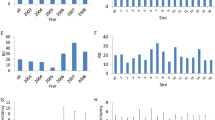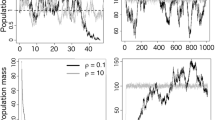Summary
Can demographic stochasticity bias the evolution of life history traits? Under a neutral version of the Cole-Charnov-Schaffer model, variance in offspring number for both annuals and perennials depends on the precise values of fitness components. Either annuals or perennials may have the larger variance (for equal λ), depending on the importance of random survivalversus fixed reproduction. By extension, the variance in offspring number should generally depend on whether λ is mainly composed of highly variable elements or elements with limited variation. Thus, data about the variability of demographic parameters may be as important as data about their mean values.
This result concerns only one source of demographic stochasticity, the probabilistic nature of demographic processes like survival. The other source of demographic stochasticity is the fact that populations are composed of whole numbers of individuals (integer arithmetic). Integer arithmetic without probabilistic demography (or environmental variation) can make it difficult for rare invaders to persist in populations even when selection would favour the invaders in a deterministic model. Integer arithmetic can also cause population coexistence when the equivalent deterministic model leads to exclusion. This effect disappears when demography is probabilistic, and probably also when there is environmental variation. Thus probabilistic demography and environmental variation may make some population patterns more, rather than less, understandable.
Similar content being viewed by others
References
Baggett, J. R. and Kean, D. (1989) Inheritance of annual flowering inBrassica oleracea.Hort. Science 24, 662–4.
Bulmer, M. G. (1985) Selection for iteroparity in a variable environment.Am. Nat. 126, 63–71.
Charnov, E. L. and Schaffer, W. M. (1973) Life history consequences of natural selection: Cole's result revisited.Am. Nat. 107, 791–3.
Chesson, P. L. (1982) The stabilizing effect of a random environment.J. Math. Biol. 15, 1–36.
Clark, C. (1978) Systematic studies ofEschscholzia (Papaveraceae). I. The origin and affinities ofE. mexicana.Syst. Bot. 3, 374–85.
Cole, L. C. (1954). The population consequences of life history phenomena.Q. Rev. Biol. 29, 103–37.
Cook, S. A. (1962) Genetic system, variation, and adaptation inEschscholzia californica.Evolution 16, 278–99.
Harris, T. E. (1963)The Theory of Branching Processes. Springer-Verlag (Die Grundlehren der Mathematischen Wissenschaften in Einzeldarstellungen 119), Berlin.
Hastings, A. and Caswell, H. (1979) Environmental variability in the evolution of life history strategies.Proc. Natl. Acad. Sci. USA 76, 4700–3.
Holsinger, K. E. and Roughgarden, J. (1985) A model for the dynamics of an annual plant population.Theor. Pop. Biol. 28, 288–313.
Karlin, S. and Taylor, H. M. (1975)A First Course in Stochastic Processes. Academic Press, NY.
Law, R., Bradshaw, A. D. and Putwain, P. D. (1977) Life history variation inPoa annua.Evolution 31, 233–46.
Metz, J. A. J. and Diekmann, O. (1986)The Dynamics of Physiologically Structured Populations. (Lecture Notes in Biomathematics 68). Springer-Verlag, Berlin.
Morishima, H. (1985) Habitat, genetic structure and dynamics of perennial and annual populations of the Asian wild riceOryza perennis. InGenetic Differentiation and Dispersal in Plants (P. Jacquard, G. Heim and J. Antonovics, eds), pp. 179–90. Springer-Verlag, Berlin.
Orzack, S. H. and Tuljapurkar, S. (1989) Population dynamics in variable environments. VII. The demography and evolution of iteroparity.Am. Nat. 133, 900–23.
Pacala, S. W. (1986a) Neighborhood models of plant population dynamics. 2. Multispecies models of annuals.Theor. Pop. Biol. 29, 262–92.
Pacala, S. W. (1986b) Neighborhood models of plant population dynamics. 4. Single-species and multispecies models of annuals with dormant seeds.Am. Nat. 128, 859–78.
Pacala, S. W. (1987) Neighborhood models of plant population dynamics. 3. Models with spatial heterogeneity in the physical environment.Theor. Pop. Biol. 31, 359–92.
Pacala, S. W. and Silander, J. A., Jr. (1985) Neighborhood models of plant population dynamics. 1. Singlespecies models of annuals.Am. Nat. 125, 385–411.
Pacala, S. W. and Silander, J. A., Jr. (1990) Field tests of neighborhood population dynamic models of two annual weed species.Ecol. Monogr. 60, 113–34.
Pollard, J. H. (1973)Mathematical Models for the Growth of Human Populations. Cambridge University Press, Cambridge, UK.
Press, W. H., Flannery, B. P., Teukolsky, S. A. and Vetterling, W. T. (1989) Numerical recipes: the art of scientific computing (FORTRAN version). Cambridge University Press, Cambridge, UK.
Schaffer, W. M. (1974) Optimal reproductive effort in fluctuating environments.Am. Nat. 108, 783–90.
Stebbins, G. L. (1974)Flowering Plants: Evolution Above the Species Level. Belknap Press of Harvard University Press, Cambridge, MA, USA.
Tuljapurkar, S. (1990) Population dynamics in variable environments. Springer-Verlag (Lecture Notes in Biomathematics 85), NY, USA.
Author information
Authors and Affiliations
Rights and permissions
About this article
Cite this article
Fox, G.A. Life history evolution and demographic stochasticity. Evol Ecol 7, 1–14 (1993). https://doi.org/10.1007/BF01237731
Issue Date:
DOI: https://doi.org/10.1007/BF01237731




